Related Research Articles
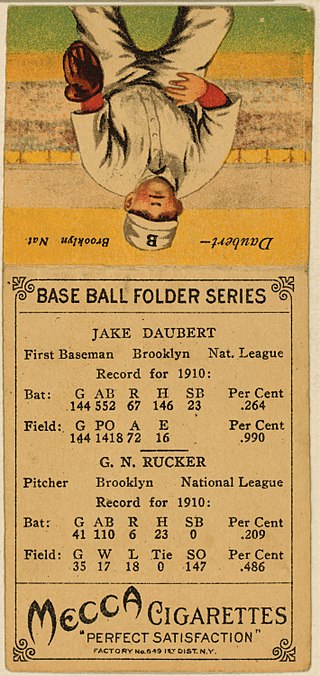
Baseball statistics include a variety of metrics used to evaluate player and team performance in the sport of baseball.
In baseball, an earned run is any run that was fully enabled by the offensive team's production in the face of competent play from the defensive team. Conversely, an unearned run is a run that would not have been scored without the aid of an error or a passed ball committed by the defense; it is "unearned" in that it was, in a sense, "given away" by the defensive team.

In baseball, hit by pitch (HBP) is an event in which a batter or his clothing or equipment is struck directly by a pitch from the pitcher; the batter is called a hit batsman (HB). A hit batsman is awarded first base, provided that he made an honest effort to avoid the pitch, although failure to do so is rarely called by an umpire. Being hit by a pitch is often caused by a batter standing too close to, or "crowding", home plate.
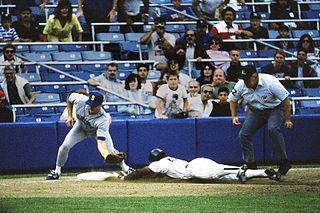
In baseball, a stolen base occurs when a runner advances to a base unaided by other actions and the official scorer rules that the advance should be credited to the action of the runner. The umpires determine whether the runner is safe or out at the next base, but the official scorer rules on the question of credit or blame for the advance under Rule 10 of the MLB's Official Rules.

Softball is a popular variation of baseball, the difference being that it is played with a larger ball, on a smaller field, and with only underhand pitches permitted. Softball is played competitively at club levels, the college level, and the professional level. The game was first created in 1887 in Chicago by George Hancock.

In many team sports, defense or defence is the action of preventing an opponent from scoring. The term may also refer to the tactics involved in defense, or a sub-team whose primary responsibility is defense. Similarly, a defense player or defender is a player who is generally charged with preventing the other team's forwards from being able to bear down directly on their own team's goalkeeper or goaltender. Such positions exist in association football, ice hockey, water polo and many other sports.
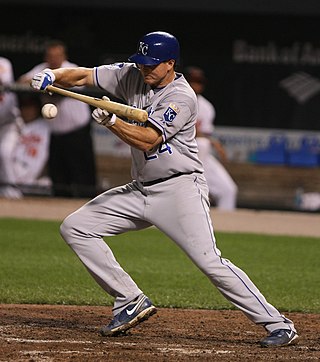
A bunt is a batting technique in baseball or fastpitch softball. Official Baseball Rules define a bunt as follows: "A bunt is a batted ball not swung at, but intentionally met with the bat and tapped slowly within the infield." To bunt, the batter loosely holds the bat in front of home plate and intentionally taps the ball into play. A properly executed bunt will create weak contact with the ball and/or strategically direct it, forcing the infielders to make a difficult defensive play to record an out.
In baseball, fielder's choice refers to a variety of plays involving an offensive player reaching a base due to the defense's attempt to put out another baserunner, or the defensive team's indifference to his advance. Fielder's choice is not called by the umpires on the field of play; rather, it is recorded by the official scorer to account for the offensive player's advance without crediting him with an offensive statistic such as a hit or stolen base.
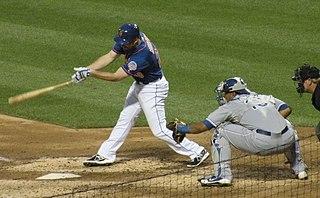
Catcher is a position in baseball and softball. When a batter takes their turn to hit, the catcher crouches behind home plate, in front of the (home) umpire, and receives the ball from the pitcher. In addition to this primary duty, the catcher is also called upon to master many other skills in order to field the position well. The role of the catcher is similar to that of the wicket-keeper in cricket.
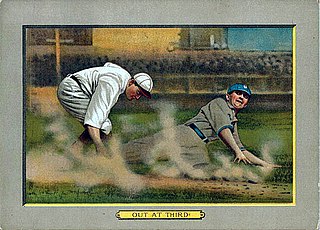
In baseball, an out occurs when the umpire rules a batter or baserunner out. When a batter or runner is out, they lose their ability to score a run and must return to the dugout until their next turn at bat. When three outs are recorded in a half-inning, the batting team's turn expires.

In baseball, the batting order or batting lineup is the sequence in which the members of the offense take their turns in batting against the pitcher. The batting order is the main component of a team's offensive strategy. In Major League Baseball, the batting order is set by the manager, who before the game begins must present the home plate umpire with two copies of his team's lineup card, a card on which a team's starting batting order is recorded. The home plate umpire keeps one copy of the lineup card of each team, and gives the second copy to the opposing manager. Once the home plate umpire gives the lineup cards to the opposing managers, the batting lineup is final and a manager can make changes only under the Official Baseball Rules governing substitutions. If a team bats out of order, it is a violation of baseball's rules and subject to penalty.
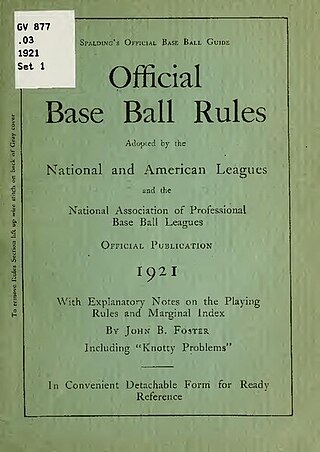
Throughout baseball's history, the rules have frequently changed as the game continues to evolve. A few common rules most professional leagues have in common are that four balls are a base on balls, three strikes are a strikeout, and three outs end a half-inning.
In baseball, interference occurs in situations in which a person illegally changes the course of play from what is expected. Interference might be committed by players on the offense, players not currently in the game, catchers, umpires, or spectators. Each type of interference is covered differently by the rules.

Pesäpallo is a fast-moving bat-and-ball sport that is often referred to as the national sport of Finland and has some presence in other places including Germany, Sweden, Switzerland, Australia, and Canada's northern Ontario. It is similar to brännboll, rounders, lapta, and baseball.
A hit and run is a high risk, high reward offensive strategy used in baseball. It uses a stolen base attempt to try to place the defending infielders out of position for an attempted base hit.
A platoon system in baseball or American football is a method for substituting players in groups (platoons), to keep complementary players together during playing time.

Bat-and-ball games, or safe haven games, are field games played by two opposing teams. Action starts when the defending team throws a ball at a dedicated player of the attacking team, who tries to hit it with a bat and then run between various safe areas in the field to score runs (points). The defending team can use the ball in various ways against the attacking team's players to force them off the field when they are not in safe zones, and thus prevent them from further scoring. The best known modern bat-and-ball games are cricket and baseball, with common roots in the 18th-century games played in England.
This is an alphabetical list of selected unofficial and specialized terms, phrases, and other jargon used in baseball, along with their definitions, including illustrative examples for many entries.
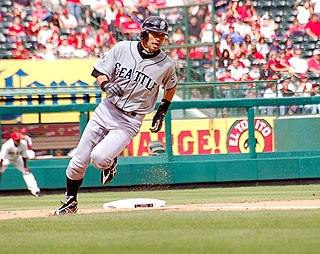
In baseball, base running is the act of running from base to base, performed by members of the team at bat.

Baseball5 (B5) is an internationally played safe haven game with many of the same rules as baseball and softball, which is governed alongside those sports by the World Baseball Softball Confederation (WBSC).
References
- ↑ "Baseball & The Tenth Inning | Ken Burns | PBS | Baseball for Beginners | Understand Game Terms | PBS". Baseball & The Tenth Inning | Ken Burns | PBS. Retrieved 2024-04-17.
- ↑ "At Bat | Glossary". MLB.com. Retrieved 2024-04-17.
- ↑ "Hit (H) | Glossary". MLB.com. Retrieved 2024-04-17.
- ↑ "Single (1B) | Glossary". MLB.com. Retrieved 2024-04-17.
- ↑ "Double | Glossary". MLB.com. Retrieved 2024-04-17.
- ↑ "Triple (3B) | Glossary". MLB.com. Retrieved 2024-04-17.
- ↑ "Home Run (HR) | Glossary". MLB.com. Retrieved 2024-04-17.
- ↑ "Walk (BB) | Glossary". MLB.com. Retrieved 2024-04-17.
- ↑ "Run (R) | Glossary". MLB.com. Retrieved 2024-04-17.
- ↑ "National Football League (NFL) | History, Teams, & Facts | Britannica". www.britannica.com. 2024-04-16. Retrieved 2024-04-17.
- ↑ "Scoring Plays | NFL Football Operations". operations.nfl.com. Retrieved 2024-04-17.
- ↑ "2023 NFL Rulebook | NFL Football Operations". operations.nfl.com. Retrieved 2024-04-17.
- ↑ Davenport, Gary. "Ranking the Top 10 Offenses in NFL History". Bleacher Report. Retrieved 2024-04-17.